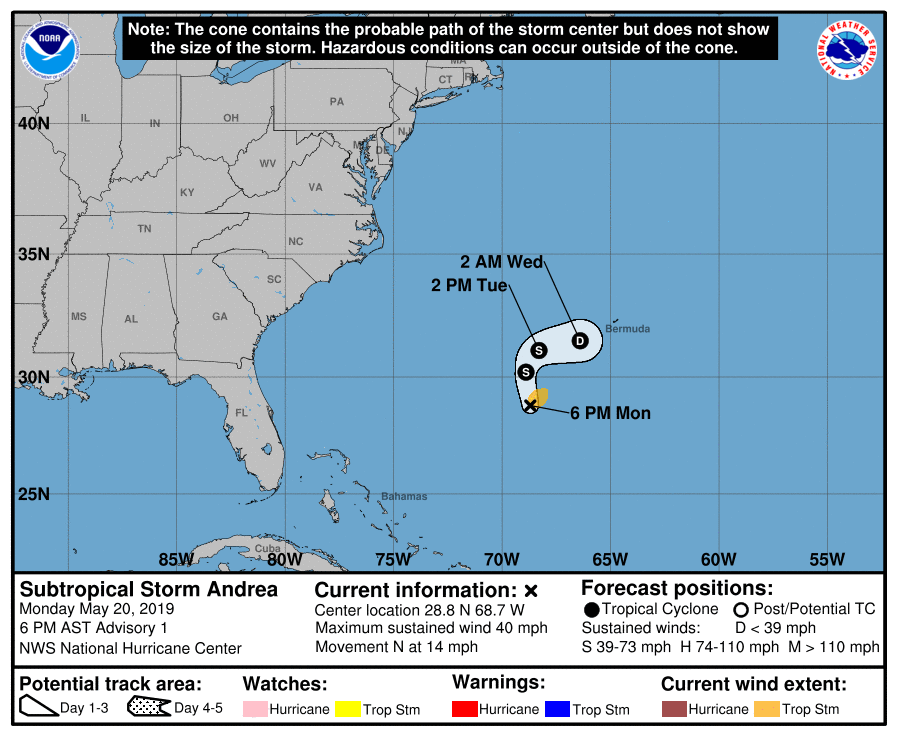Subtropical Storm Andrea forms in the North Atlantic

Subtropical Storm Andrea seen by the GOES-16 satellite shortly before its official designation at 20:30 UTC May 21, 2019

An area of disturbed weather which the National Hurricane Center (NHC) has been monitoring for the past three days has been officially designated as Subtropical Storm Andrea, the first named storm of the 2019 Atlantic hurricane season. An Air Force “Hurricane Hunter” reconnaissance aircraft was flying into the storm Monday afternoon and reported a well-defined surface circulation, satisfying the criteria for a tropical or subtropical cyclone. The cyclone was classified as subtropical, rather than tropical, due to its appearance in satellite imagery, its large radius of maximum winds (RMW), and the fact that it is interacting with an upper-level low. The NHC is forecasting some slight additional strengthening tonight before weakening begins on Tuesday, and Andrea is expected to be absorbed by a frontal system on Wednesday. The cyclone has the potential to bring some impact to Bermuda as a weakening system or a post-tropical cyclone, although effects, if any, are likely to be minor.
A Pre-Season Cyclone Streak Continues
Andrea’s formation on May 20 marks the fifth consecutive time that an Atlantic hurricane season has featured a pre-season tropical or subtropical cyclone in the North Atlantic. This series of pre-season cyclones goes back to 2015, when Subtropical Storm Ana developed on May 8, transitioning to a tropical cyclone before impacting the Carolinas. The Atlantic got another surprise in January 2016 when Subtropical Storm Alex formed on January 12 and became a fully tropical hurricane, one of only three to exist in the North Atlantic during January. In 2017, Tropical Storm Arlene became only the third tropical or subtropical storm to form in the North Atlantic in the month of April on record, alongside a subtropical storm in April 1992 and Tropical Storm Ana of 2003, when it formed on April 19. And in 2018, Tropical Storm Alberto formed on May 25, later impacting Cuba and the Gulf coast of the United States. With the recent series of pre-season cyclones forming in the North Atlantic, one might wonder if the Atlantic hurricane season should begin earlier than it currently does on June 1. This is no new question, and it has been a topic of debate among tropical enthusiasts, and some have pushed to change the official start of the season to a date before June 1. However, only 27 tropical and subtropical storms have developed in the month of May in the North Atlantic since official records began in 1851, and they occur much less frequently than tropical and subtropical cyclones do in the month of June. Additionally, an earlier start date to the Atlantic hurricane season would interfere with off-season activities, including technical development of tropical cyclone warning products, as well as public awareness efforts such as Hurricane Preparedness week. However, that’s a topic for another time.
Force Thirteen Outlets
You can follow Andrea’s progress and other tropical news through Force Thirteen’s outlets. You can keep up with updates by following Force Thirteen’s official Facebook and Twitter accounts. Subscribe to the Force Thirteen YouTube channel for daily tropical weather bulletins, tropical updates, and severe weather updates.
